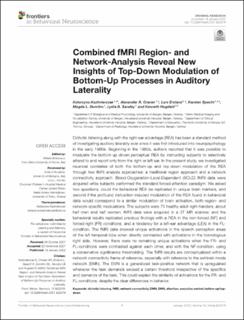| dc.contributor.author | Kazimierczak, Katarzyna | |
| dc.contributor.author | Craven, Alexander R. | |
| dc.contributor.author | Ersland, Lars | |
| dc.contributor.author | Specht, Karsten | |
| dc.contributor.author | Dumitru, Magda L. | |
| dc.contributor.author | Sandøy, Lydia B. | |
| dc.contributor.author | Hugdahl, Kenneth | |
| dc.date.accessioned | 2022-03-03T13:09:57Z | |
| dc.date.available | 2022-03-03T13:09:57Z | |
| dc.date.created | 2022-01-25T16:27:42Z | |
| dc.date.issued | 2022 | |
| dc.identifier.issn | 1662-5153 | |
| dc.identifier.uri | https://hdl.handle.net/11250/2982843 | |
| dc.description.abstract | Dichotic listening along with the right-ear advantage (REA) has been a standard method of investigating auditory laterality ever since it was first introduced into neuropsychology in the early 1960s. Beginning in the 1980s, authors reported that it was possible to modulate the bottom-up driven perceptual REA by instructing subjects to selectively attend to and report only from the right or left ear. In the present study, we investigated neuronal correlates of both the bottom-up and top-down modulation of the REA through two fMRI analysis approaches: a traditional region approach and a network connectivity approach. Blood-Oxygenation-Level-Dependent (BOLD) fMRI data were acquired while subjects performed the standard forced-attention paradigm. We asked two questions, could the behavioral REA be replicated in unique brain markers, and second if the profound instruction-induced modulation of the REA found in behavioral data would correspond to a similar modulation of brain activation, both region- and network-specific modulations. The subjects were 70 healthy adult right-handers, about half men and half women. fMRI data were acquired in a 3T MR scanner, and the behavioral results replicated previous findings with a REA in the non-forced (NF) and forced-right (FR) conditions, and a tendency for a left-ear advantage (LEA) in the FL-condition. The fMRI data showed unique activations in the speech perception areas of the left temporal lobe when directly contrasted with activations in the homologous right side. However, there were no remaining unique activations when the FR- and FL-conditions were contrasted against each other, and with the NF-condition, using a conservative significance thresholding. The fMRI results are conceptualized within a network connectivity frame of reference, especially with reference to the extrinsic mode network (EMN). The EMN is a generalized task-positive network that is upregulated whenever the task demands exceed a certain threshold irrespective of the specifics and demands of the task. This could explain the similarity of activations for the FR- and FL-conditions, despite the clear differences in behavior. | en_US |
| dc.language.iso | eng | en_US |
| dc.publisher | Frontiers Media | en_US |
| dc.rights | Navngivelse 4.0 Internasjonal | * |
| dc.rights.uri | http://creativecommons.org/licenses/by/4.0/deed.no | * |
| dc.title | Combined fMRI Region- and Network-Analysis Reveal New Insights of Top-Down Modulation of Bottom-Up Processes in Auditory Laterality | en_US |
| dc.type | Journal article | en_US |
| dc.type | Peer reviewed | en_US |
| dc.description.version | publishedVersion | en_US |
| dc.rights.holder | Copyright 2022 Kazimierczak, Craven, Ersland, Specht, Dumitru, Sandøy and Hugdahl | en_US |
| dc.source.articlenumber | 802319 | en_US |
| cristin.ispublished | true | |
| cristin.fulltext | original | |
| cristin.qualitycode | 1 | |
| dc.identifier.doi | 10.3389/fnbeh.2021.802319 | |
| dc.identifier.cristin | 1989782 | |
| dc.source.journal | Frontiers in Behavioral Neuroscience | en_US |
| dc.identifier.citation | Frontiers in Behavioral Neuroscience. 2022, 15, 802319. | en_US |
| dc.source.volume | 15 | en_US |

